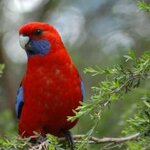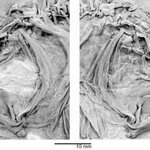Evolution

Tiny fossilized teeth excavated from an Indian open-pit coal mine could be the oldest Asian remains ever found of anthropoids, the primate lineage of today's monkeys, apes and humans, say researchers from Duke University and the Indian Institute of Technology.
Just 9-thousandths of a square inch in size, the teeth are about 54.5 million years old and suggest these early primates were no larger than modern dwarf lemurs weighing about 2 to 3 ounces. Studies of the shape of the teeth suggest these small animals could live on a fruit and insect diet, according to the researchers.
"It's certainly…

A new study published today in Proceedings of the Royal Society B investigates the genetic and geographical relationships between different forms of crimson rosellas and the possible ways that these forms may have arisen.
Dr Gaynor Dolman of CSIRO's Australian National Wildlife Collection says there are three main color 'forms' of the crimson rosella – crimson, yellow and orange – which originated from the same ancestral population and are now distributed throughout south eastern Australia.
"Many evolutionary biologists have argued that the different forms of crimson rosellas arose, or…

In a new study published in the online-open access journal PLoS ONE, Per Christiansen at the Zoological Museum in Copenhagen, Denmark, reports the finding that the evolution of skull and mandible shape in sabercats and modern cats were governed by different selective forces, and the two groups evolved very different adaptations to killing.
The cat family comprises some of the most specialized carnivores in the history of mammals, all exclusively eating flesh. The cat family consists of two major sub-groups: the feline cats (including all modern species) and the sabertoothed cats (which are…

Bacteria living on opposite sides of a canyon have evolved to cope with different temperatures by altering the make-up of their 'skin', or cell membranes, write scientists who have found that bacteria change these complex and important structures to adapt to different temperatures by looking at the appearance of the bacteria as well as their genes. The researchers hope their study, published in the August issue of Microbiology, will start a new trend in research.
The cell membrane is one of the most important and complex parts of a cell. Membranes contain different fatty acid molecules; the…

Below is the final statement emerging from the Altenberg workshop, agreed upon by all 16 participants. Individual commentaries about the workshop will be posted on the KLI web site, and MIT Press will publish the full proceedings by the end of 2009.
A group of 16 evolutionary biologists and philosophers of science convened at the Konrad Lorenz Institute for Evolution and Cognition Research in Altenberg (Austria) on July 11-13 to discuss the current status of evolutionary theory, and in particular a series of exciting empirical and conceptual advances that have marked the field in recent times…

"Survival of the fittest" is the catch phrase of evolution by natural selection. While natural selection favors the most fit organisms around, evolutionary biologists have long wondered whether this leads to the best possible organisms in the long run.
A team of researchers at The University of Texas at Austin, led by Drs. Matthew Cowperthwaite and Lauren Ancel Meyers, has developed a new theory, which suggests that life may not always be optimal.
Genetic mutations create the raw material that natural selection acts upon. The short-term fate of a mutation is often quite clear. Mutations…

Genomic imprinting is a mechanism that regulates gene expression in the developing fetus and plays a major role in regulating its growth. Research published in Nature Genetics by a team of international scientists has established an identical mechanism of genetic imprinting which evolved 150 million years ago.
"This paper shows that we share a common genetic imprinting mechanism which has been active for about 150 million years despite the differences in reproductive strategies between marsupials and humans," said Professor Geoffrey Shaw of the Department of Zoology at the University of…

Hidden away in museums for more that 100 years, some recently rediscovered flatfish fossils have filled a puzzling gap in the story of evolution and answered a question that initially stumped even Charles Darwin.
All adult flatfishes--including the gastronomically familiar flounder, plaice, sole, turbot, and halibut--have asymmetrical skulls, with both eyes located on one side of the head. Because these fish lay on their sides at the ocean bottom, this arrangement enhances their vision, with both eyes constantly in play, peering up into the water.
Skull of heteronectes chaneti, showing…

After taking a fresh look at an old fossil, John Flynn, Frick Curator of Paleontology at the American Museum of Natural History, and colleagues determined that the brains of the ancestors of modern Neotropical primates were as small as those of their early fossil simian counterparts in the Old World. This means one of the hallmarks of primate biology, increased brain size, arose independently in isolated groups—the platyrrhines of the Americas and the catarrhines of Africa and Eurasia.
"Primatologists have long suspected that increased encephalization may have arisen at different points in…
Charles Darwin (1809-1882) opened his first notebook about "the species question" in 1837, not long after his return from the voyage of the Beagle. By 1838, he had developed the basic outline of his theory of natural selection to explain the evolution of species. He spent the next 20 years developing the theory and marshalling evidence in favour of both the fact that species are related through common descent and his particular theory to explain this. After receving word that another naturalist, Alfred Russel Wallace (1823-1913), had independently come upon the same theory…